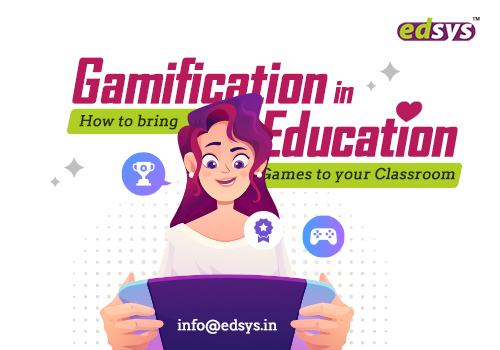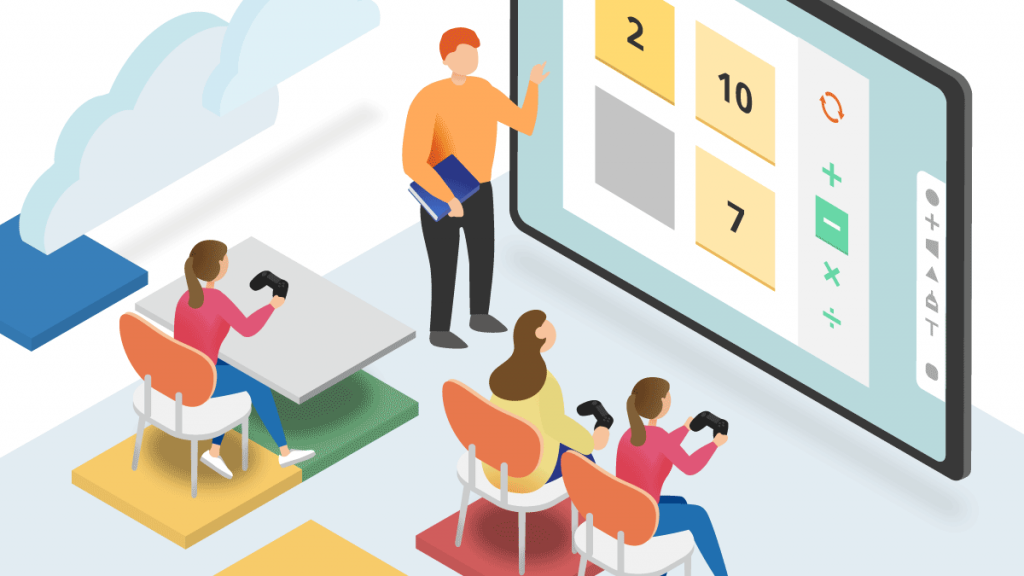Categories(658 Blogs)
Select Category
Watch Right Now
Teacher App - Class
Schedule & Attendance Management App
Parent App from Edsys

Best School Bus Tracking System

Cashless School - For Smart Schools of Tomorrow


Gamification in Education: How to bring Games to your Classroom?

What is Gamification?
“Gamification is about taking something that is not a game and applying game mechanics to increase user engagement, happiness, and loyalty!”
Gamification is all about taking elements from game-design, the theories and principles that drive gameplay are taken out and apply it to other contexts.
The term ‘gamification was coined back in 2002 by Nick Pelling, a British-born computer programmer, and inventor.
The demand and popularity of gamification have increased than ever. Gamification has even introduced in the field of education also.
In this article, we will discuss
-
Gamification in Education
-
How can I gamify education in my classroom?
-
Advantages of Gamification
-
Disadvantages of Gamification
-
Reasons to Implement Gamification
Gamification in Education

Educators have used the theory of gamification in education and the results were positive. It is seen that students tend to be proactive when words like ‘games’, ‘play’, ‘fun’, ‘missions’ are used in front of students.
These reasons prompted educators to introduce gamification in education. They put forth new techniques of learning using technology.
Hence, various tech companies have started working on ways to make learning fun and effective.
Also Read: Why is it Important For Teachers to Study Philosophy of Education?
Subjects were imparted to students in a playful manner using the methods of gamification. Thus leading 21st-century kids to engage more in studies, know their interests, self-learning methods were exhibit to create child-centric learning through gamification.
How can I gamify education in my classroom?
Introducing gamification in education helps to boost classroom engagement, collaboration and learning.
Let’s see some of the ways it can be done:
- Start giving learning badges instead of points or grades
- Games like scavenger hunts, dice games, Scrabble, Connect Four, etc can be adopted in classroom learning
- Play bingo cards for language learning
- Play interesting competition within the class and reward the winners, such as a 1- minute dance party, extended recess time, etc
- Let your students to set their goals and to track their own progress
- Divide students into groups and play quizzes
Advantages and Disadvantages of gamification
Advantages of Gamification
-
Increase Learner Engagement
While imparting gamification in education, it encourages healthy competition among students and they take up challenges. It can result in higher productivity and to achieve the learning objectives effectively.
-
Improve learners knowledge absorption and retention
Students are ready to take up problem-solving strategies across various levels of play or contexts.
-
Provide instant feedback
Whether positive or negative, feedbackis delivered instantly. Students can monitor their progress throughout the game and they may feel intrinsically motivated to complete the game successfully.
-
Assist students in applying the skills to real world contexts and problems
The things they have imparted from gamification can be applied in real-life scenarios. They achieve better problem solving ability.
-
Make social connections, promote cooperation and team work
Forming them into teams and organizing various activities promote their team working and cooperation skills.
Disadvantages of Gamification
-
Decrease student attention span
While gamified learning provide students with immediate feedback, they expect the same response from all parts of their education and in real life. Failure to receive immediate feedback may eventually result in frustration among children
-
Budget and resources
The costs of gamified learning vary depending on the types you are choosing. Software costs, equipment costs, training costs or even instructor costs may be there.
-
Student Assessment
Educators choose games that are befitting into your course assessment. It should be able to rightly fulfill the learning objectives. For this matter, teachers may need to spend a good time choosing a game.
- May lead to overstimulation or an addiction towards gameplay
- Chances are more for students to ignore other learning activities like hands-on experiments and simulations
Reasons to Implement Gamification
Gamification is a teaching methodology that creates a game-like scenario focusing on the course curriculum and objectives. This strategy is being adopted worldwide to enhance education and to reap higher results.
The strategies such as leader boards, scores, badges, etc are used to represent student achievements in a playful manner.
These kinds of tactics are made to motivate students, leadership qualities, manage time effectively, etc.
It also encourages their problem-solving skills and foster collaboration among students. It helps to increase the popularity of technology among students. Teachers should adopt new teaching methods to complement gaming principals to leverage the process of engaging and educational for the students.
Recent Blogs
Our Educational Services
Popular Blogs
Subscribe

SUBSCRIBE TO OUR NEWSLETTER
Sign Up and Recieve the Latest News
Don’t Worry, We Don’t SpamExplore Our Extensive Researched Educational App Directory
Visit Now
















